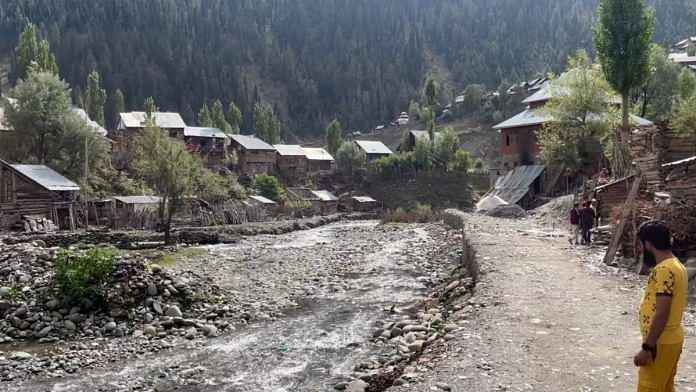Thank you dear subscribers, we are overwhelmed with your response.
Your Turn is a unique section from ThePrint featuring points of view from its subscribers. If you are a subscriber, have a point of view, please send it to us. If not, do subscribe here: https://theprint.in/
The Pahalgam terror attack is turning out to be a defining moment in the geopolitical landscape of South Asia. While it brought two nuclear-armed neighbours to the brink of war, it also renewed global attention—not just to South Asia, but specifically to Kashmir. The U.S. President’s repeated obsession with Kashmir—his fixation on resolving a “1000-year-old dispute” and constant references to mediation—has raised many eyebrows. This obsession may appear to stem from an “innocent” desire for peace. However, the strategic implications behind such gestures must be carefully examined. Reviving the idea of Kashmir as a “disputed territory” and the U.S. as a potential peace-broker carries deeper geopolitical motives.
Trump’s Kashmir obsession is not new. In 2019, he had offered to mediate, but after his intervention, India made a bold unilateral decision by revoking Article 370. This move was a message to the world that Kashmir is an integral part of India and not up for third-party negotiation. But the recent war has once again brought Kashmir into the global spotlight—much to the displeasure of India.
Because of the internationalisation of the Kashmir issue, many countries are actively entering the discussion. Historically, China—a long-time ally of Pakistan—has supported Islamabad’s stance on Kashmir. But this time, it’s not just China. Pakistan has succeeded in leveraging support from countries such as Turkey, Azerbaijan, and even some Middle Eastern nations. While support from the Gulf remains ambiguous, Turkey—with its Islamic ideological affinity to Pakistan—has fully backed Pakistan’s stance on Jammu & Kashmir, extending even to military cooperation.
What’s more concerning is India’s growing diplomatic isolation, even in its immediate neighbourhood. The fall of the Hasina regime and the rise of an Islamic, pro-Pakistan government in Bangladesh—which shares the longest border—is being seen by many analysts as a CIA-sponsored coup—a tested formula of using Islamic regimes to further U.S. strategic interests. With Turkey, Pakistan, Azerbaijan, and now Bangladesh potentially speaking in one voice, a new front may be forming under the pretext of Islamic solidarity.
The U.S. stand is also evoking growing suspicion. Washington’s active role in pushing for an IMF bailout package for a struggling Pakistani economy raises serious questions, as Pakistan, for a significant period of time, was on the IMF’s grey list.
What’s even more shocking is that President Trump recently nominated members with a known history of association with Lashkar-e-Taiba (LeT)— listed as a terrorist group by the same the U.S. and India considers it responsible for terror attacks in India and its activity in Kashmir—to the White House advisory board. This has stunned Indian observers and confirms fears that U.S. policy continues to flirt with radical Islamist networks when it suits its imperial interests. From propping up Islamic regimes during the Cold War to funding armed groups in the Middle East and Afghanistan, the U.S. has consistently used radical Islamic groups as a proxy for its geopolitical ends and to maintain its hegemony in different regions. Kashmir now appears to be the next pawn in this imperial game within South Asia.
With China’s rise and shifting global power dynamics, the U.S. appears to be refocusing on Kashmir as a strategic lever in South Asia. Many in India view this as a warning: either align with U.S. interests on trade, defense, and global strategy—or face pressure via Kashmir.
India, in recent years, has signaled a Western tilt by joining the QUAD and aligning with the West’s Indo-Pacific vision. But the weakening of American global dominance—challenged by China, Russia, and multipolar platforms like BRICS—is presenting India with new strategic options. U.S. economic protectionism and its “tariff terrorism” have already strained mutual trust. Russia’s warning about Western attempts to divide China and India has added to New Delhi’s anxieties. China’s vulnerabilities in Xinjiang and Tibet make it acutely sensitive to unrest in neighboring regions. The U.S. can contain even China using Pakistan’s influence in Kashmir as a pressure point, along with India.
The spectre of NATO-style backchannel deals is knocking on Kashmir’s door. The Turkey-U.S. convergence on Gaza shows that when interests align, ideology becomes flexible. History has shown us that these powers rarely come to extinguish fires—they come to manage and manipulate them. From Iraq to Libya to Afghanistan, U.S. involvement has left behind more ashes than peace. China, too, seeks to shape narratives under the guise of balance—but for its own ends.
The sudden resurgence of interest in Kashmir has little to do with our dignity and everything to do with global alignments. We are not seen as people, but as pawns—a bargaining chip in the hands of global powers. For these powers, Kashmir is not a tragedy to be healed—it is a tool to be used. Our suffering and instability strengthen their hand at international negotiating tables. Kashmiris must respond with clarity, not confusion; wisdom, not impulse.
Vikas Amin is a Kashmir-based political analyst.
These pieces are being published as they have been received – they have not been edited/fact-checked by ThePrint.



Best read of the week. Hats off to author
Brilliant articulation by a young man.